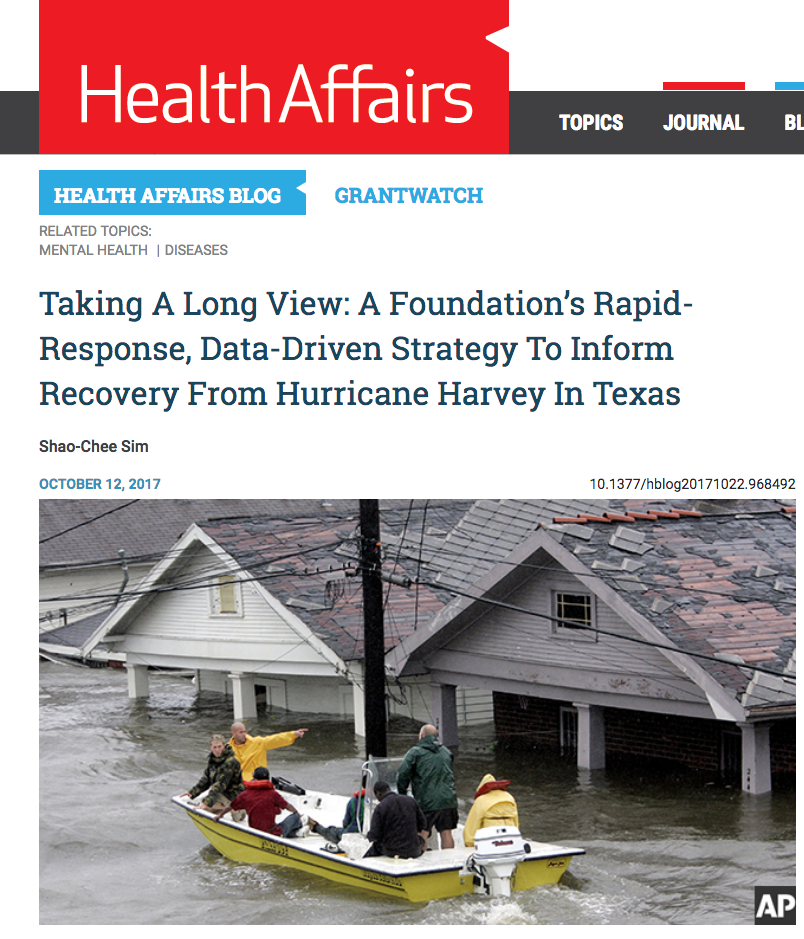
By Shao-Chee Sim, EHF’s VP for Applied Research
This blog post originally appeared in Health Affairs
When Hurricane Harvey made landfall as a Category 4 hurricane near Rockport, Texas, on August 25, 2017, we knew there would be massive winds and torrential rains. But none of us understood, and will probably not understand for some time, the full extent of the impact of this natural disaster in communities throughout the Gulf Coast region—from Texas to Louisiana.
What we do know is that with a record fifty-two inches of rainfall in parts of the region, the flooding has had devastating effects. To date, 829,825 individual assistance applications have been received by the Federal Emergency Management Agency (FEMA) and $1.85 billion in federal funds have been provided to Texans. Jefferson County Judge Jeff Branick lamented that “homelessness and housing recovery” is now his biggest concern. That’s because 25 percent of the county’s 81,000 residents lost their homes because of flooding. (Beaumont and Port Arthur are in Jefferson County, Texas.) Piles of waterlogged furniture, wet drywall, and other debris still line the streets in neighborhood after neighborhood in affected communities. Each pile represents a family, memories lost, and more struggles to come.
In addition to dealing with the physical dislocation of residents as a major public policy priority, concerns about drinking water and the storm’s impact on mental health remain major public health priorities. More than two weeks after Hurricane Harvey hit various affected communities, 200-plus drinking water systems were impaired or shut down—161 had boil-water notices, and fifty-two were shut down. The storm affected more than 1 million students and 220 school districts across the region. In addition to dealing with a compressed academic calendar, many school districts’ superintendents have had to develop immediate counseling services for students as they returned to schools.
As Episcopal Health Foundation (EHF) staff returned in early September after a week-long absence because of the storm, our leadership team quickly realized that rather than react “quickly” and “emotionally,” we should take a more thoughtful approach in devising our response to the tragedy. We watched federal, state, and local governments respond to this crisis and learned about the creation of various Hurricane Harvey relief funds.
However, as we conferred with colleagues in philanthropy across the country, we understood there’s a critical data gap. It’s difficult for groups wanting to help to truly understand the extent of damage through the affected communities and the short-term and long-term challenges facing the most vulnerable populations affected by this disaster—that is, people who are elderly, low-income, renting a place to live, and/or the undocumented.
First, using a geographic information system (GIS) mapping file from the FEMA website, we have created a user-friendly, interactive map that shows the extent of property damage throughout the affected region. The analysis was conducted using parcel data on buildings and homes, as well as flood inundation data showing the depth of water levels in different areas.
This data-mapping tool (featured below) is available to help national foundations, Texas funders, and other recovery efforts better understand the scope of damage across Texas. It’s designed to give these organizations the most accurate information available to help them make good decisions about how to invest in recovery projects that best address the public health and other complex needs of our region.
While this is the largest dataset currently available from FEMA to gauge damage, this should not be seen as a final and complete assessment of all damage in the region. It is, nonetheless, an important first step to building a comprehensive examination of the effect of Hurricane Harvey in Texas.
EHF conducted a nationwide webinar about the mapping tool on September 18 with more than 50 staffers from foundations, government agencies, and nonprofits.
Equally important, we have added overlays from the Centers for Disease Control and Prevention (CDC)–developed social vulnerability index (SVI) and four sub-indexes (socioeconomic status, household composition & disability, minority status & language, and housing and transportation) to the property damage map. The SVI indicates the relative vulnerability of every US Census tract. Created by the Agency for Toxic Substances and Disease Registry’s (ATSDR’s) Geospatial Research, Analysis, and Services Program (GRASP), the SVI tool is intended to help public health officials and emergency response planners identify and map the communities that will most likely need support before, during, and after a future emergency event, such as severe weather, floods, disease outbreaks, or chemical exposure.
While these overlaid maps show many affected communities were already highly vulnerable in many aspects of the SVI, we hope that these maps can inform both short-term and long-term rebuilding needs of various communities, as well as the amount of resources devoted to future emergency planning in these communities. These SVI indexes comprised important social determinants of health data, such as language, age, poverty, housing, and transportation challenges, which could inform public health and mental health professionals in planning and implementing services to help residents in the affected communities.
Second, EHF is currently partnering with the Henry J. Kaiser Family Foundation to conduct a probability-based, randomized survey of Texans in the affected counties, as well as qualitative research with the most vulnerable populations affected by the disaster. In particular, the survey will include questions on accessing disaster benefits, health care services, and mental health needs.
We are concerned that while there is going to be a large amount of government money and philanthropic funding available for Hurricane Harvey recovery, the voices of the most vulnerable may not be represented during the decisions on how to invest those funds. We hope to release the survey results in early December.
We hope the mapping tool and findings from research about the most vulnerable populations affected by Hurricane Harvey can inform discussions and decisions being made regarding the long-term priorities of rebuilding efforts in Texas.